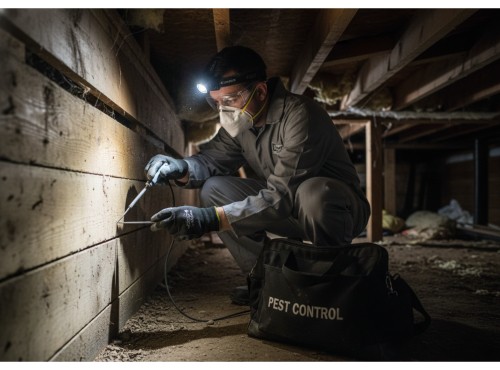Scope and Purpose of Professional Inspection
The purpose of a termite inspection is to identify structural vulnerabilities before colony expansion results in extensive damage. PMPs conduct a complete evaluation from foundation to roofline, applying technical methods defined in the Canadian Pest Management Association (CPMA) standards. These include:
- Visual assessment of exposed and accessible structures such as perimeter slabs, joists, sill plates, rim boards, and sub-flooring materials.
- Moisture reading using dielectric or pin-type meters to detect elevated humidity levels within wood, a primary condition supporting subterranean activity.
- Examination of structural voids, including crawl spaces, wall cavities, and areas under decks or porches where termites often establish galleries.
- Identification of ingress points, such as foundation cracks, deteriorated sill plates, and gaps surrounding utility penetrations.
- Documentation of building history, including any previous pest activity, material upgrades, and structural modifications using pressure-treated or resistant lumber.
Older homes near Rosedale, the Annex, and the Beaches, many of which feature brick-and-timber construction, often present complex inspection scenarios. Aging materials, microbial decay, and non-standard construction details may conceal foraging tunnels or frass accumulations within voids.
The GTA Inspection Workflow
In the Toronto region, professional inspections typically start outdoors along the foundation perimeter. Technicians look for telltale signs such as pencil-width mud tubes on concrete surfaces, displaced soil near window wells, and conditions promoting excess moisture retention. Using hand tools, probes, and inspection mirrors, PMPs identify structural gaps or decayed elements at ground contact points.
Basement and crawl space inspections follow, focusing on conditions such as hydrostatic pressure, condensation, and direct wood-to-soil contact. When required, sub-slab monitoring devices are installed to detect foraging galleries or termite movement beneath concrete surfaces. Interior evaluations involve tapping joists and sill plates to detect hollow timber, using boroscopes to examine inaccessible spaces, and conducting ventral inspection beneath stairs or flooring.
A field example from Midtown Toronto illustrates this process well. In a detached residence near Yonge and Bloor, the inspector concentrated on brick foundation seams, moisture readings around the sump pit, and the wooden porch supports adjoining the sill plate. In the Distillery District, where heritage structures retain original wooden beams, inspections often require access behind masonry facades and within confined crawl spaces. These conditions demand advanced inspection tools and adherence to preservation standards set by the Ministry of Natural Resources and Forestry (MNRF).
Deliverables and Reporting Protocol
A professional termite inspection culminates in a detailed site report containing:
- Annotated site diagrams marking key risk areas including foundation walls, decks, and crawl spaces.
- Documentation of conducive conditions, such as wood-to-soil contact, drainage issues, and vegetation bridging.
- Evidence of termite indicators, such as discarded wings, mud-tube formation, and hollow-sounding timber.
- Recommendations for corrective actions, including moisture mitigation, exclusion work, and preventive treatments.
- Cost projection tables, outlining treatment tiers and maintenance options for clarity and transparency.
The table below illustrates a standard reporting framework used across Toronto:
| Inspection Element |
Purpose |
Tools / Methods Used |
| Foundation Perimeter |
Identify mud tubes, soil disturbance |
Visual inspection, probe tools |
| Crawl Space & Basement |
Detect moisture and voids |
Moisture meter, flashlight, mirror |
| Structural Voids |
Locate hidden foraging galleries |
Drill & treat access points, boroscope |
| Attic & Upper Levels |
Identify secondary infestations |
Flashlight, tapping technique |
| Exterior Landscaping |
Evaluate bridging risks |
Grade survey, vegetation assessment |
Localized Environmental Variables
Toronto’s built environment presents challenges rarely seen elsewhere in Canada. The combination of dense housing, high humidity from Lake Ontario, and heritage construction creates ideal conditions for subterranean termite expansion. Homes near the Don Valley and the waterfront districts often experience increased foundation moisture due to fluctuating water tables. Similarly, neighborhoods with tight spacing, such as Queen Street West or Trinity Bellwoods, exhibit higher incidence of termite ingress via deck posts and garden mulch directly abutting exterior walls.
Seasonality also affects inspection scheduling. Though subterranean termites remain active throughout the year, major inspection drives typically occur between late March and early May, coinciding with the alate swarming period. Identifying shed wings or new mud-tube formations during this phase allows PMPs to confirm colony activity before damage becomes extensive.
Recognizing Termite Activity: Early Indicators in Toronto Properties
Detecting termite presence early is the cornerstone of effective prevention. The National Pest Management Association (NPMA) identifies subterranean termites as the most destructive structural pest in North America, with colonies capable of consuming cellulose material undetected for years. Within Toronto’s humid microclimate, particularly near the Don Valley, High Park, and the Lake Ontario shoreline, conditions often favor silent infestation.
Homeowners and property managers should be alert to distinct physical indicators, which technicians confirm during inspections using both visual and tactile methods. These include:
- Mud Tubes: Thin earthen tunnels extending from soil to foundation, often visible along basement walls or exterior slabs. These structures protect termites from desiccation and predators while maintaining the moisture necessary for survival.
- Discarded Wings: Swarmers, or alates, shed their wings once they establish a new colony. Piles of wings on window sills, vents, or sub-floor areas usually signify nearby nesting activity.
- Hollow or Bubbling Wood: When tapped, infested timber emits a hollow sound because termites consume wood internally, leaving an outer shell intact. Paint bubbling or blistering can accompany this symptom.
- Swollen Doors and Windows: Wood deformation from termite tunneling or moisture absorption may cause doors and window frames to stick.
- Frass and Pellet Ejection Sites: Although subterranean species in Ontario typically build mud tubes instead of ejecting droppings, isolated piles of fine, sand-like pellets near cracks or joints should be examined carefully.
- Moisture Anomalies: Persistent dampness, condensation, or pooling in crawl spaces and basements often create a habitat conducive to colony formation.
When these clues are identified, PMPs will conduct moisture readings, evaluate foundation interfaces, and in some cases, deploy monitoring stations to confirm termite foraging behavior. These techniques, rooted in Integrated Pest Management (IPM) methodology, support both preventive and remedial decision-making.
Control Methodologies in Professional Termite Management
Following inspection and confirmation of infestation or conducive conditions, control measures must be tailored to the site’s construction and environmental characteristics. Professional pest control operators across Toronto adopt strategies grounded in regulatory compliance and entomological science.
- Liquid Soil and Sub-Slab Treatments
This technique remains a cornerstone of termite control across Canada. PMPs apply non-repellent liquid termiticides around the foundation perimeter and through concrete slabs. The application often requires trenching and sub-slab injection, creating a continuous treated zone that intercepts foraging workers.
According to Health Canada’s Pest Control Products (PCP) regulations, all termiticides must be registered and applied strictly at label rates. Professionals commonly use suspension concentrate (SC) or microencapsulated (ME) formulations that offer long-term residual control. Holes drilled through basement slabs or patios are sealed post-treatment to maintain aesthetic integrity and prevent vapor migration.
- Baiting Systems and Colony Suppression
Baiting provides a targeted, environmentally considerate option, particularly in urban neighborhoods like the Annex or Leslieville where soil access may be restricted. PMPs install tamper-resistant bait stations containing cellulose laced with an insect growth regulator (IGR) or chitin synthesis inhibitor, which prevents termite molting and colony reproduction.
The system functions through trophallaxis. Worker termites share bait among the colony, ultimately eliminating the queen. Common brands, including Sentricon®, are frequently used in Canada under Health Canada registration. These systems align with IPM protocols, reducing the need for widespread soil treatment while providing ongoing population monitoring.
- Structural Injection and Void Treatment
In heritage homes or exposed basements, localized treatment through injection ports or void application becomes necessary. PMPs use precision equipment to introduce termiticidal foam or liquid directly into galleries and wall cavities. This method is particularly effective in older Toronto districts like Cabbagetown, where preserving original woodwork limits invasive intervention.
Void treatments must comply with WHMIS safety standards and may involve re-entry intervals (REI) to ensure occupant safety during curing periods. Documentation of these safety measures forms part of the final treatment report.
- Moisture and Habitat Correction
Control efforts are incomplete without environmental modification. Because subterranean termites require moisture, mitigation involves regrading soil away from the foundation, sealing cracks, and reducing wood-to-soil contact. PMPs often recommend installation of dehumidifiers, gutter adjustments, and vegetation trimming near exterior walls.
A homeowner’s participation in these preventive adjustments significantly enhances long-term protection. The NPMA and CPMA emphasize that integrated structural and environmental corrections remain the most sustainable component of any termite management plan.









